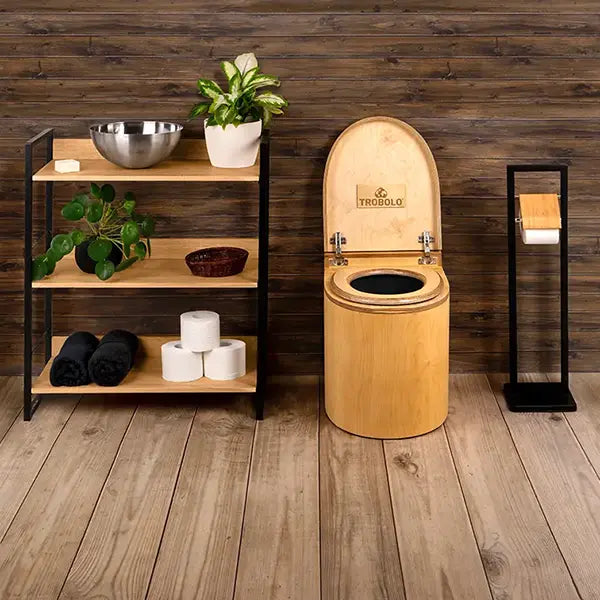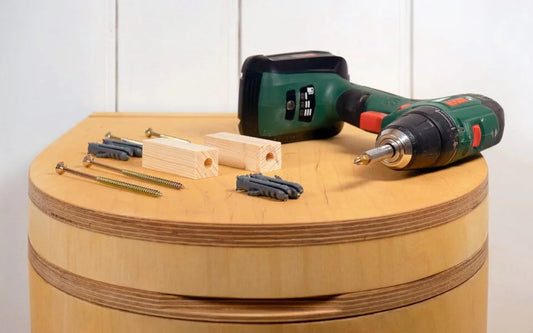

Our tiny house toilets at a glance
What is a tiny house toilet good for?
A tiny house toilet is a toilet system that meets the special needs of tiny houses. Even though tiny houses can be designed in many different ways, the available space is usually limited. Also, connection options to water and electricity circuits are not always commonplace.
As a result, the suitability of conventional toilets for use in tiny houses is limited. Without connections to the sewage system, traditional toilets cannot be used at all. On the other hand, the lack of space can also be a barrier to installing a conventional toilet. And this is exactly where tiny house toilets come into play, as they ideally combine compact dimensions, convenient use and self-sufficient functionality. Below we present the most important toilet options for use in a tiny house.
What are the best tiny house toilets?
Basically, there are two possible options for tiny houses:
- A conventional toilet with connection to the water system
- A connection-free composting toilet
Other solutions such as chemical toilets or outhouse toilets are not typically used, as they are hardly suitable for long-term use and have considerable disadvantages.
Both conventional toilets and composting toilets enable comfortable toilet use in tiny houses. Ultimately, the choice depends on personal preferences as well as the conditions of the tiny house in question.
Some tiny houses must have a connection to the water supply due to local regulations. In Germany, for example, such a connection obligation applies to any permanently inhabited properties. If a wastewater connection has been installed, a traditional toilet can be connected and the faeces can be flushed into the local wastewater system as usual.
However, if the appropriate connections are not available and you are not obliged to retrofit them for legal reasons, the composting toilet is a convenient alternative that does not involve any structural alterations.
A composting toilet is a self-contained system that separates solid and liquid waste from each other when using the toilet and collects it in separate containers. In addition to their connection-free operation, composting toilets are easy to use and odourless.
Even with existing water connections and the option of installing a normal toilet, more and more tiny house owners still prefer to use a composting toilet. The motivation for this varies, as there are numerous advantages to using a composting toilet:
- Absolutely odourless in use
- Self-sufficient without water and chemicals
- Optional composting of faeces
- Environmentally friendly operation
- Easy disposal of toilet waste
- Compact, attractive design
How does a tiny house composting toilet work?

The functionality of a tiny house composting toilet is based on an integrated urine diverter that effectively separates solid and liquid waste from each other when using the toilet.
Solid waste ends up in the solids container at the back of the composting toilet, while liquids are directed into an integrated liquids container or an external tank via the front section. Composting toilets with an integrated liquids container that are suitable for use in a tiny house include our TROBOLO LunaBlœm, SilvaBlœm and TeraBlœm. A suitable tiny house toilet with external urine drainage, on the other hand, is our TROBOLO TinyBlœm, which has a corresponding hose that can be connected to an external tank.
Regardless of whether the liquids are discharged into an integrated liquids container or external tank, the separation of the waste minimises the development of odours and the additional addition of litter or use of an electric exhaust system ultimately eliminates unpleasant odours entirely. For use in a tiny house, we recommend models with an electric exhaust system, as these are ideal for continuous toilet operation and ensure that there is no odour at any time.
Disposing of the faeces is easy. Liquid waste can either be disposed of via a regular toilet or diluted with water and used as a natural fertiliser for ornamental plants. Solid waste can be disposed of in the residual waste including the inlay, similar to used diapers. Alternatively, composting of the solid waste is also possible.
This enables all-round convenient toilet use that does not require a water connection, takes up little space and can convert any room into a bathroom.
A TinyBlœm in a tiny house
Please note that this video is in German. You can turn on subtitles for a better viewing experience.
Building your own DIY tiny house toilet
If you are looking for a customised solution and want to build your own composting toilet for your tiny house, you can use our DIY accessories. Here we show you how to build your own composting toilet step by step.
Composting toilets are a great fit for tiny houses
As tiny houses often offer little space and do not always have reliable water and electricity connections, the equipment poses a unique challenge, including the choice of a suitable toilet.
For tiny houses without water and waste water connections, the composting toilet is an ideal, odourless and environmentally friendly solution that is easy to install and operate. Its compact dimensions, self-sufficient functionality and absolute odourlessness are so convincing that it can be an interesting alternative to the classic toilet, even where connections are available.
FAQ
Frequently Asked Questions
Here you will find short and clear answers to questions we are frequently asked.
Do you need planning permission for a composting toilet in a tiny house?
A composting toilet is a self-contained system that typically does not require planning permission. However, if in doubt, you should check with the relevant local authority or agency.
Do I need an electric exhaust system if I use a composting toilet in my tiny house?
It is not absolutely necessary to use an electric exhaust system, as you can also use litter as an alternative to prevent unpleasant toilet odours. However, we recommend the electric exhaust system for use in tiny houses, as experience has shown that this offers more comfort when the composting toilet is in continuous use.
My tiny house does not have a power connection, can I still use an electric exhaust system?
Yes, our energy-saving electric exhaust system can be operated using a power bank, for example, and has a USB port for flexible connection options.
The best models for your home
Our tiny house toilets
-

"Do-it-yourself" is the latest trend, so it's not surprising that more and more people want to build their composting toilet themselves. But how does that actually work?
Build your DIY composting toilet with ease
"Do-it-yourself" is the latest trend, so it's not surprising that more and more people want to build their composting toilet themselves. But how does that actually work?
-

In this TROBOLO guide on composting in the garden, we show you how to properly compost organic waste in your own garden. This allows you to support the natural cycle...
How and what to compost - The ultimate guide
In this TROBOLO guide on composting in the garden, we show you how to properly compost organic waste in your own garden. This allows you to support the natural cycle and at the same time obtain nutrient-rich humus.
-

Here you will learn everything about the emptying process of our TROBOLO composting toilets and the disposal of toilet waste.
How to empty a composting toilet
Here you will learn everything about the emptying process of our TROBOLO composting toilets and the disposal of toilet waste.








